30 Open Kitchen Ideas for Small Spaces That Make Every Inch Count in 2025
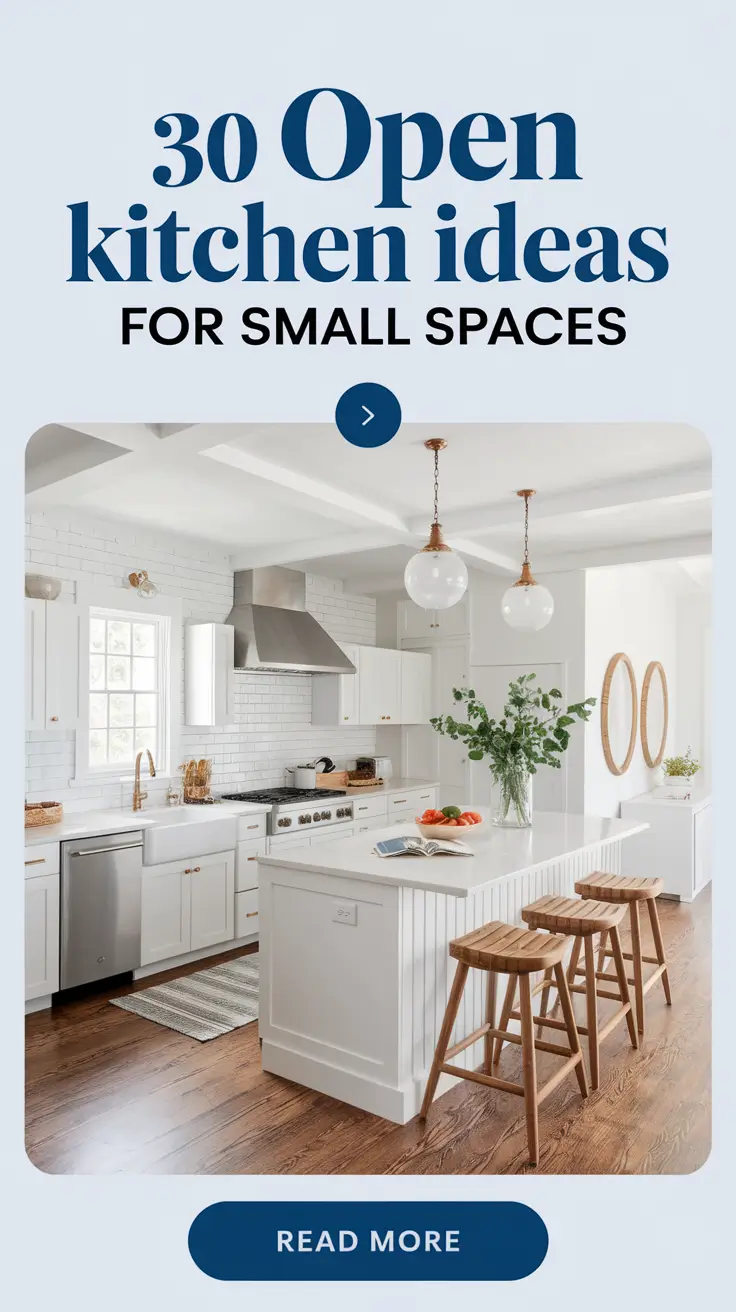
You need wise solutions for open kitchen spaces which maintain aesthetic appeal as well as functionality despite limited room dimensions. Understanding the process of uniting living spaces with kitchens for a cohesive attractive design system within minimal spaces such as studio apartments or tiny houses will be addressed in this guide.
This guide provides practical solutions for people who need to work within a budget as well as those building modern spaces for 2025. The discussion emphasizes space-maximizing techniques which allow you to design a functional layout adapted to your needs while generating a double-size effect.
Maximize Every Inch With A Seamless Open Kitchen Layout
Every successful open kitchen design for small spaces relies on proper layout according to my experience. A smooth flow of movement between the cooking and dining areas subsequently sets the overall ambiance. The design works best for apartment living spaces and homes without kitchen walls that merge into the living area. The single-wall or galley style provides continuous visual flow between different areas without any interruptions.

Your floor space becomes more functional when you incorporate a skinny island or drinking area table serving both as additional counter area. The use of light-colored cabinets with low profiles helps create a sense of airiness by reflecting light. An open shelf positioned near windows together with ceiling-high shelving maximizes vertical space effectively. The overall organization remains smooth because under-cabinet lighting combines with consistent hardware choices throughout the zones.

I prefer this floor plan design for condominiums and older homes with former partition walls between kitchens and living spaces. Dwell experts together with HGTV professionals suggest utilizing an open floor plan for homes smaller than 900 sq ft. I completely agree with this approach because the functional advantages become obvious right away.
A few layouts require additional sound-absorbing solutions and smart pantry storage systems. Discreet pull-out drawers and soft-close systems should be considered for installation to stop cabinet noises from spreading through open areas.
Blend Your Kitchen Into The Living Room With Style
A well-designed transition between kitchen and living room areas produces the best outcome for creating an airy environment. The connection of two adjacent areas in small apartments becomes possible through finishing treatments that match along with creative zone definitions. A seamless look occurs when you use the same flooring between rooms while furniture guides boundary transitions through lighting fixtures as well as shelves and rugs.
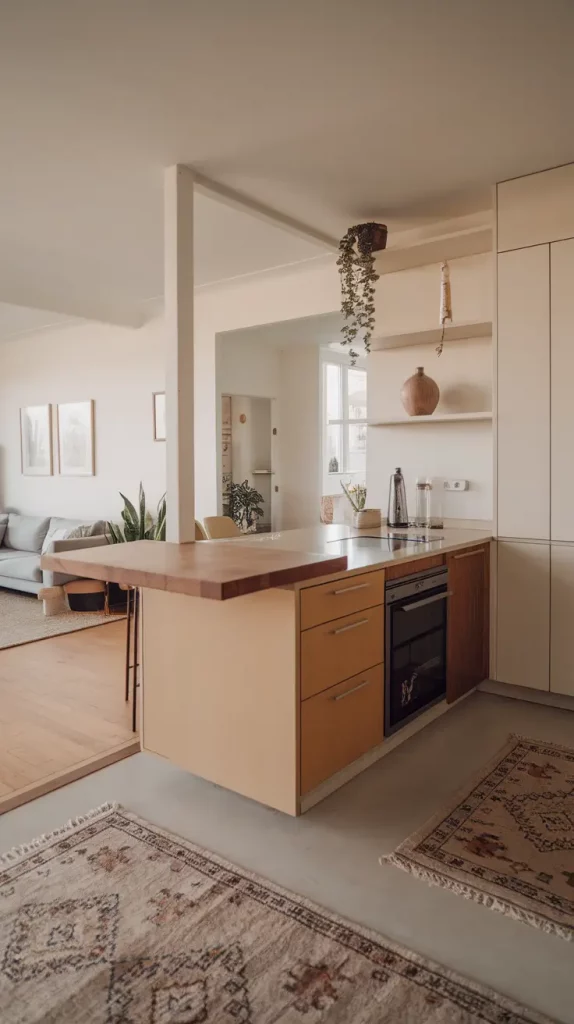
My design approach relies on a basic color scheme featuring wood tones with black matte details and pale white paint. The built-in wall includes cabinets and open shelving which functions as kitchen storage and living room display. The floating shelves that hang above the counter serve as a perfect transition between the counter area and media walls. The same island serves as a cooking station while also functioning as a television stand. Every element works double duty.

I drew my design ideas from Better Homes & Gardens’ article about flexible furniture pieces during my house renovation. There was a remarkable concept to merge breakfast bar space with relaxed seating during the design. The arrangement created a cohesive and relaxing atmosphere instead of the tight and fragmented feeling.
A lightweight curtain or sliding panel would be my recommendation to achieve this look because it provides visual separation without requiring permanent walls while still allowing you to conceal the kitchen during entertaining events.
Clever Shelf Placement That Doubles As Kitchen Storage
Tight living conditions demand that shelves become more than decoration because they serve as organizational tools. Open wall shelves serve as cabinet replacements to maintain an unobstructed feeling in the room. Open shelves arranged properly can showcase glassware and cookbooks and plants alongside clearing up the area beneath for counter usage.
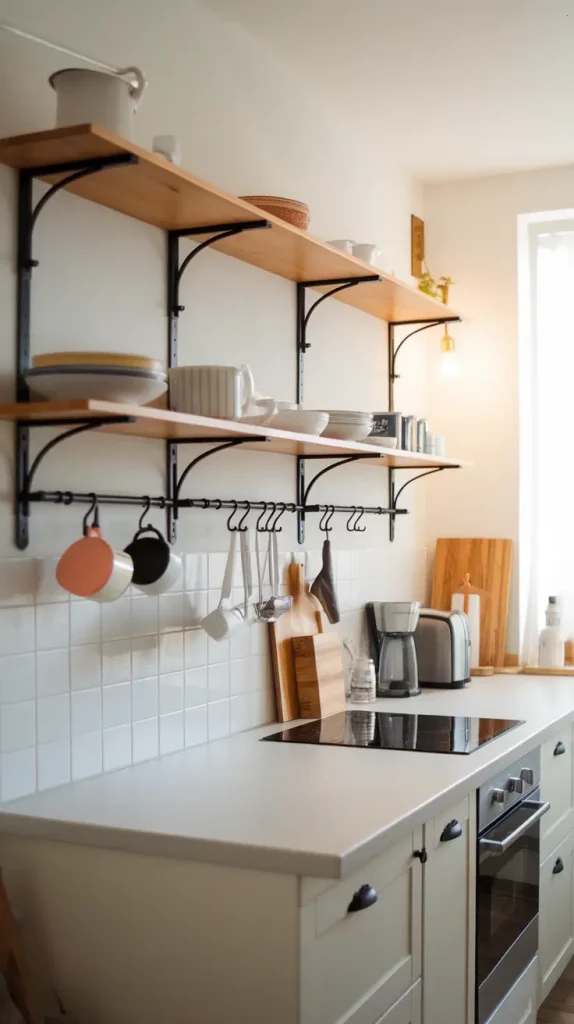
The combination of solid wood brackets and natural-tone wood planks with matte black finish provides both durability and attractive appearance. Open shelves work best when arranged at different heights for visual appeal but always maintain order because disorganized display looks unappealing to everyone. Hooks attached underneath the shelves serve as great storage options for mugs and utensils. We implemented picture-ledge-style shelves which proved excellent for storing spices and oils during a particular project.

The idea for vertical optimization emerged when I read Apartment Therapy’s article. The 500-sq-ft condo kitchen conversion to vertical storage became permanent after my initial test. The room became taller and lighter with a personal touch from the carefully selected display.
To improve my current design I recommend adding LED lights below the shelves as well as mirrored back panels to increase space depth.
Opt For Upper Cabinets That Open Up The Visual Flow
The storage needs of some spaces require modern upper cabinets as an alternative to open shelving. The use of frameless push-to-open cabinets should be strategic to prevent visual enclosure in small open kitchen designs.
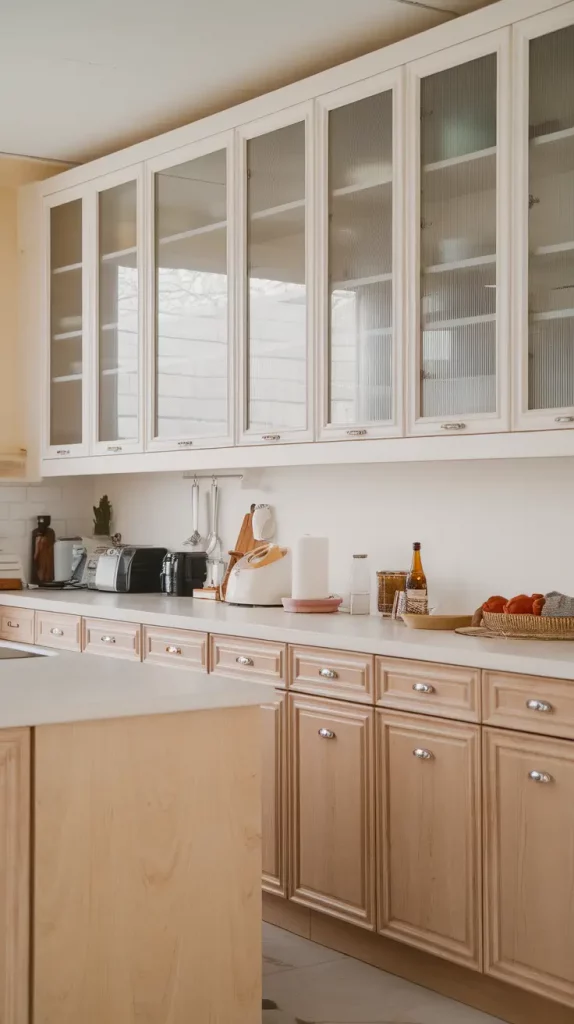
The storage cabinets I choose feature ivory or pastel green or sand-colored finishes which I position slightly above standard height to make the space appear larger. Frosted glass doors function as excellent solutions for maintaining light flow while hiding what lies inside. I have chosen floating shelves underneath the cabinets as an alternative to create an informal balance against their formal structure.
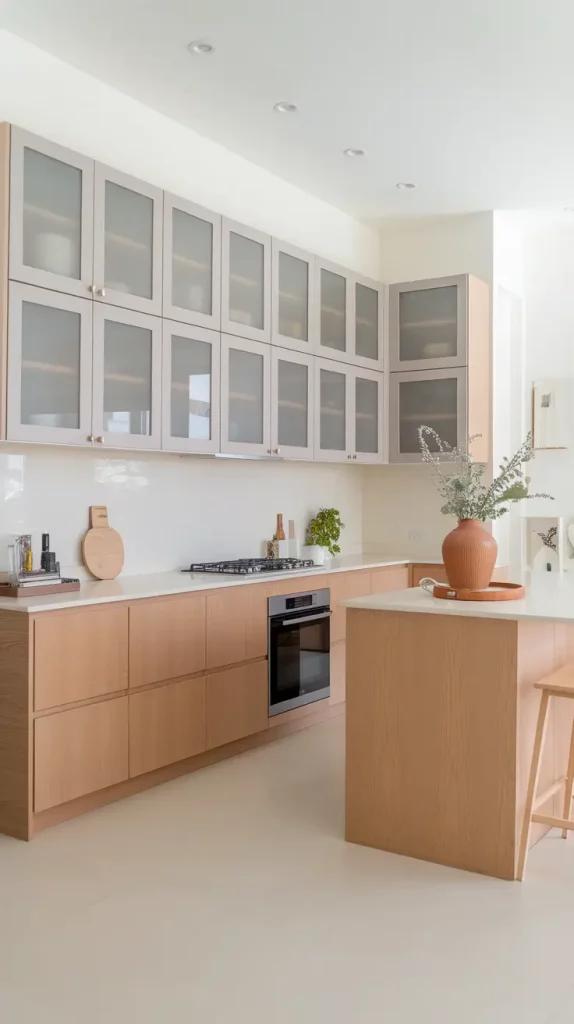
The loft in Brooklyn benefited from this approach. The clients appreciated how the upper cabinets disappeared into the wall surface. The design in Elle Decor featured a matchless combination of high-gloss compartments with open wood storage which created an eye-catching aesthetic.
The setup could be enhanced by extending the cabinetry to reach the ceiling where I would store occasional-use items along with essential items in the lower section.
Floating Shelving Ideas That Keep Things Light And Airy
The availability of limited floor space requires spaces to maintain visual openness. The floating shelving system serves as my primary choice when working on small kitchen spaces. The shelves provide storage solutions that enhance wall appearance by creating a light atmosphere. These shelves bring personal touches to spaces which standard closed cabinets fail to achieve.
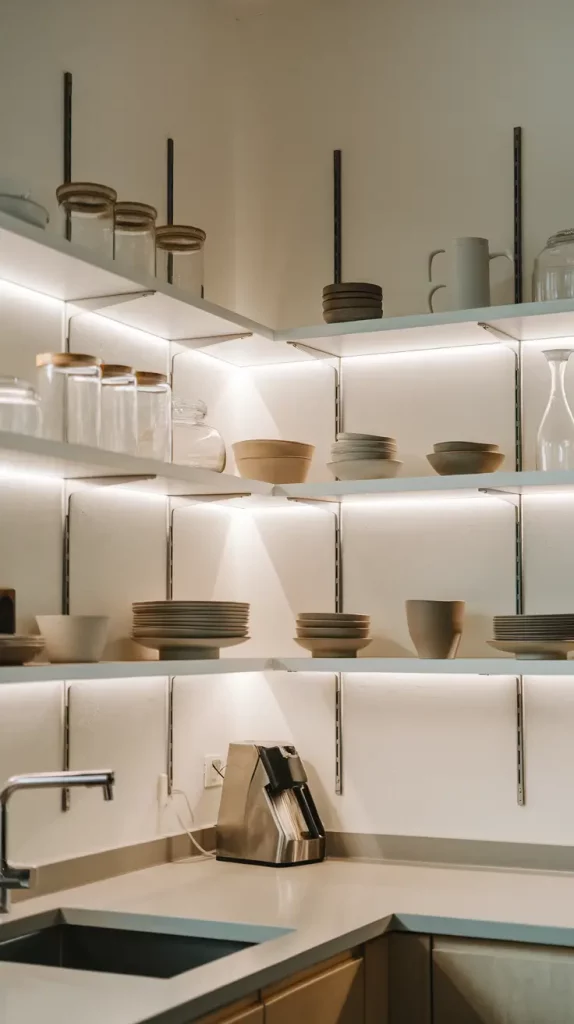
I install two or three floating shelves above a brief backsplash area using minimalistic brackets or hidden support systems. These shelves work well for displaying both glass containers with dry goods and hand-made pottery. Tall cabinets become softer in appearance during transitions when these shelves are strategically positioned alongside them.

Domino Magazine features alongside my personal projects demonstrate that floating shelves consistently deliver boutique appeal to small kitchens. These shelves provide openness while delivering a gallery-like appeal which emerges through proper styling.
I would install accent lighting beneath or above the shelves to highlight the open feel and ensure the whole arrangement appears carefully designed instead of accidental.
Blend Kitchen And Lounge Areas With Cohesive Design Elements
Studio apartments and concept tiny houses need a natural transition between kitchen and living room areas. The unification of a whole space occurs through cohesive design elements which unite through consistent use of colors, materials and shapes.

My designs combine matching hardware between cabinets and pair upholstery with backsplash colors while using the same shelving units across both kitchen and living spaces. A shared lighting source such as pendants or track lighting will effectively unify different areas in the unit. A powerful design technique involves matching the wood finish of kitchen stools with coffee tables while extending wall paint across all areas.

During my recent design work I combined matte olive green cabinets with a matching velvet armchair for the lounge area. The tiny detail united the two areas without requiring any effort. A 2025 trend forecast by Dwell describes repetition as the strongest method in designing small spaces.
I would improve this design approach by implementing adjustable furniture pieces which transform between kitchen seating and coffee table resting surfaces.
Budget-Friendly Upgrades For Small Open Kitchens
A complete renovation is not required to achieve stylish kitchen transformations. Budget design requires me to implement creative improvements that avoid shifting walls or plumbing systems. New lighting together with fresh paint and modern hardware transforms the whole atmosphere of an open-plan kitchen that joins with the living room.

My cabinet painting process begins first since matte greige and dusty blue are perfect choices. Upgrading old pulls with matte black bars represents a basic yet effective design modification. The combination of IKEA open shelves together with reclaimed wood slabs proves to be an inexpensive solution for adding both functionality and personality. The peel-and-stick tile I installed as a backsplash in that home only cost less than $100.

The core of my design approach focuses on spending money on the items homeowners touch frequently such as faucets and handles and lighting. Pay attention to budget makeovers which appear in Real Simple and House Beautiful publications. Often, these transformations feel just as rich as high-end remodels.
The budget design can be enhanced through the addition of compact seating or a fold-down breakfast bar which also provides storage underneath.
Modern Kitchen Looks That Suit Compact Spaces
My approach to designing compact kitchens always begins with modern design principles. Strengthened lines combined with reflective materials and reduced disorder result in spacious appearances. These open kitchen designs that work for small areas depend on basic designs and practical elements. The elegant nature of modern design enables the space to simplify itself instead of creating denseness within compact arrangements. Dormant color schemes appear together with contrasting components to create sufficient dramatic impact while avoiding visual confusion.

My design includes flat-panel cabinets finished in matte or gloss which come in white, soft gray and deep navy colors based on the room lighting conditions. A modern kitchen design achieves breathability through its narrow backsplash and drawerless cabinets and open shelving. The polished look in kitchens emerges from barstools with thin legs and built-in lighting features as well as sleek appliances. The relationship between hidden storage and viewable elements in my designs ensures practicality meets aesthetic quality.

The modern kitchen design proves exceptionally beneficial for studio apartments as well as new-build homes. I implemented this design approach in a 650 square feet condominium located in downtown. The white-and-wood color combination from Dwell Magazine transformed the compact arrangement into a spacious appearance.
To elevate this design I would introduce greenery or textured wall art which would both round the lines and bring personal style to the area.
Integrate A Kitchen Into The Floor Plan Of Your Living Room
Making the kitchen and floor plan living room harmonize is a design challenge that brings deep satisfaction to designers. When dealing with open-concept spaces less than 800 sq ft you should carefully combine areas into one unified space for both visual effect and extra available room. Your kitchen cabinets’ matte oak finish should guide your selection of media consoles or bookshelves which should match this tone.
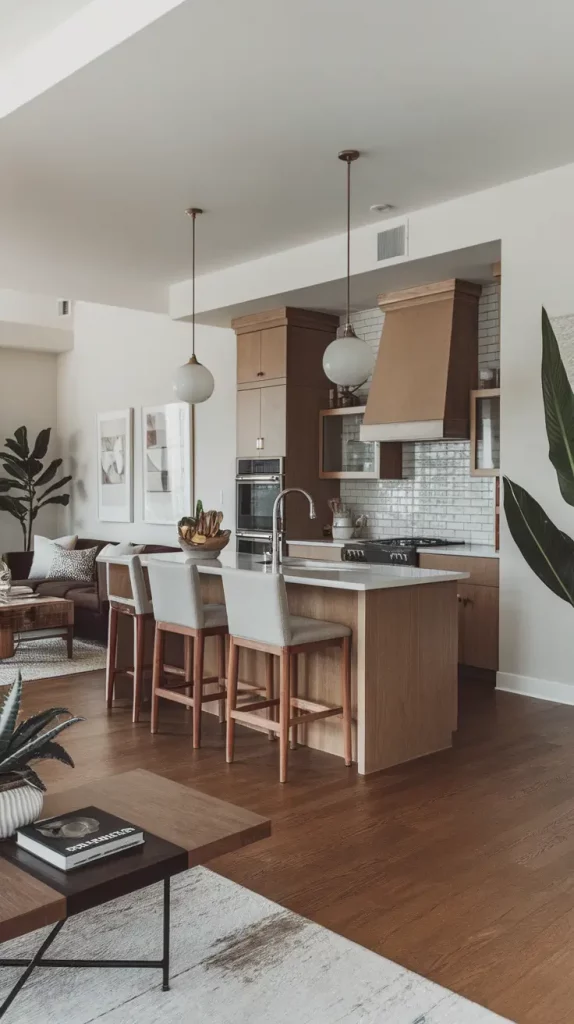
The kitchen wall I work with stretches across a space that transitions smoothly into seating areas without dividing walls. A project succeeds with flooring that matches the overall scheme by using warm-toned hardwood or seamless LVT. The kitchen island together with tall shelving units act as soft partition elements to define space areas. The design element organizes the room effectively without blocking its social atmosphere.
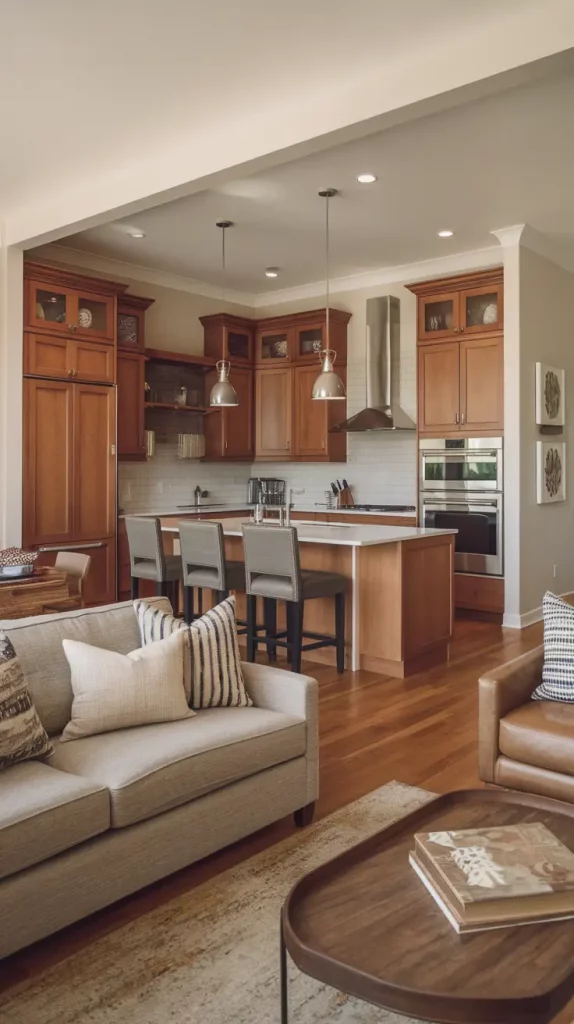
I designed a galley kitchen that faces the sofa wall in my house while using pendant lighting to establish visual stability. Elle Decor presents a zoning method that helps provide visual stability to open floor plans according to their article. The natural transition of guests from kitchen to living room space proved very beneficial during social events.
The kitchen design would achieve maximum cohesion through adding an area rug which duplicates the colors found in the backsplash or cabinetry. This simple addition delivers substantial visual benefits.
Add Storage Without Bulk Using Slimline Shelving
The top open kitchen designs for compact areas incorporate storage solutions through the implementation of slimline shelving which I consider a fantastic method. The space from these shelves extends additional countertop area while preserving unobstructed views regardless of their limited footprint size. The dimensions of these shelves remain under 8 inches deep so they can be installed above sinks and windows or over doorways.
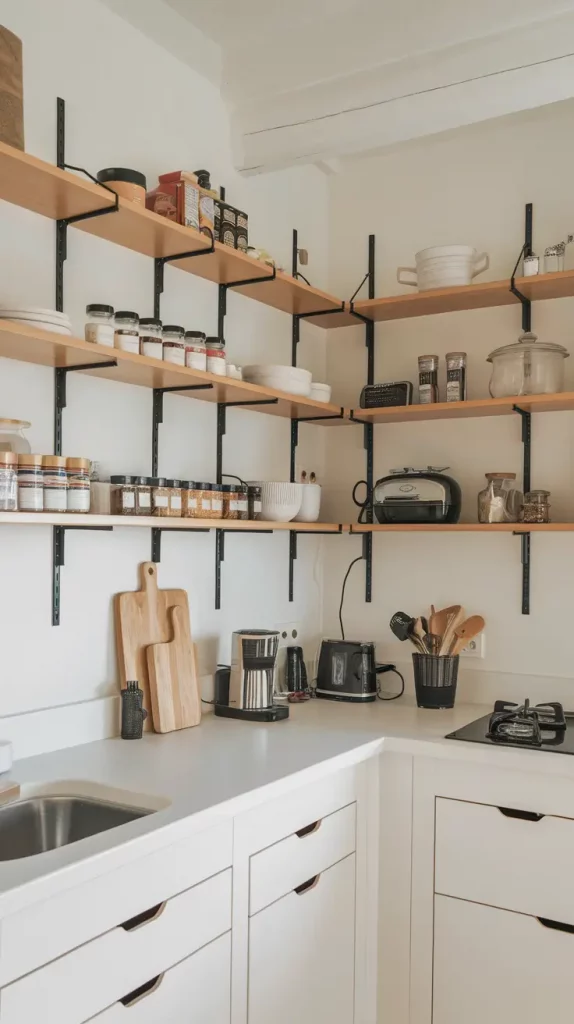
I select matte black or brushed brass brackets as my preferred choice to introduce contemporary elements into the design. The design materials include both reclaimed wood and tempered glass among others based on the desired aesthetic. A narrow shelf installed beneath the ceiling across an entire wall became an ideal spot to store less-frequently-used items that looked beautiful when illuminated from below.
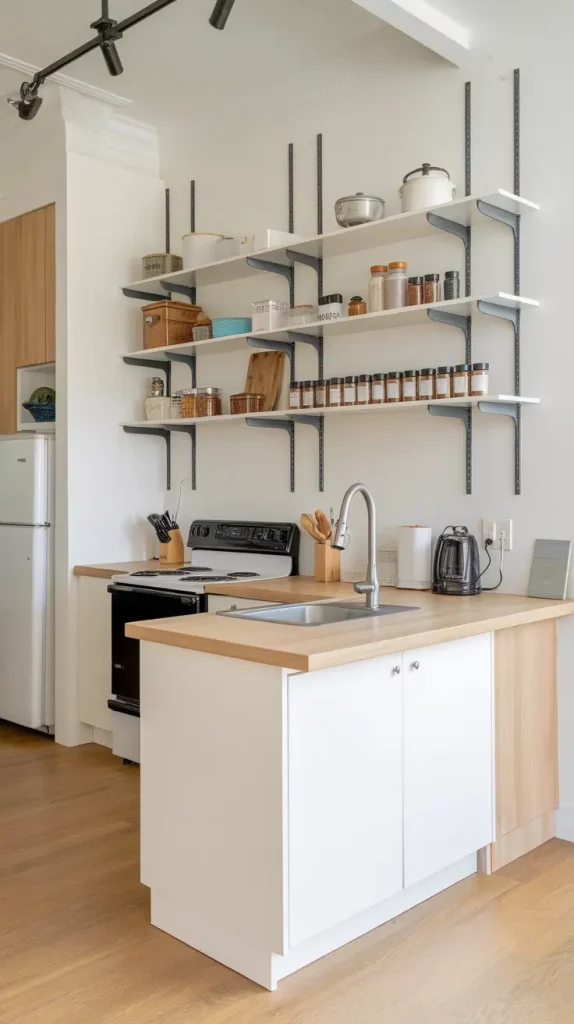
My experience shows that this design method functions as an essential solution for people who rent or design with limited funds. This design method provides affordable installation speed and multiple usage options. The kitchen appeared entirely new after adding minimal floating shelves but removing upper cabinets.
The addition of hidden lighting beneath shelves combined with magnetic knife holders or vertical rail systems for utensils would be an excellent recommendation.
Mirrored Cabinets To Amplify Space And Light
When you want to create more space in a compact kitchen the installation of mirrored cabinets stands as my top design recommendation. The reflective quality of mirrors creates an effective solution for compact spaces that need illumination and open-up restricted areas especially in contemporary kitchen designs and tiny house concepts.
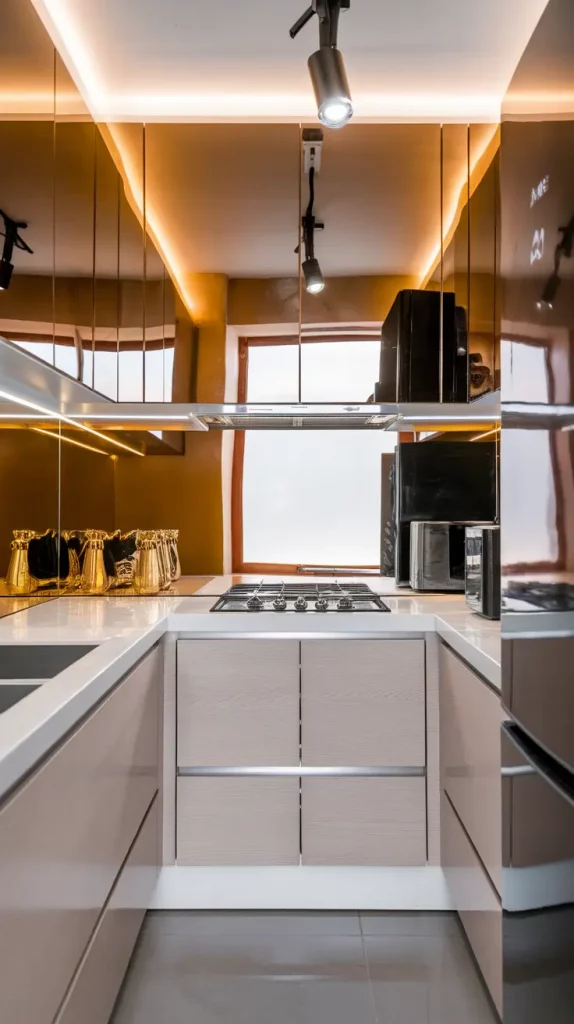
A smoked or soft-gloss mirrored finish should be your choice for cabinets in this design. These cabinets create an elegant yet earthy appearance when they meet matte materials or wood textures. I install the reflective elements at eye level above counter surfaces but maintain solid lower cabinets for visual contrast. The reflective surface remains unbroken when you use minimal handles or touch-latch systems.
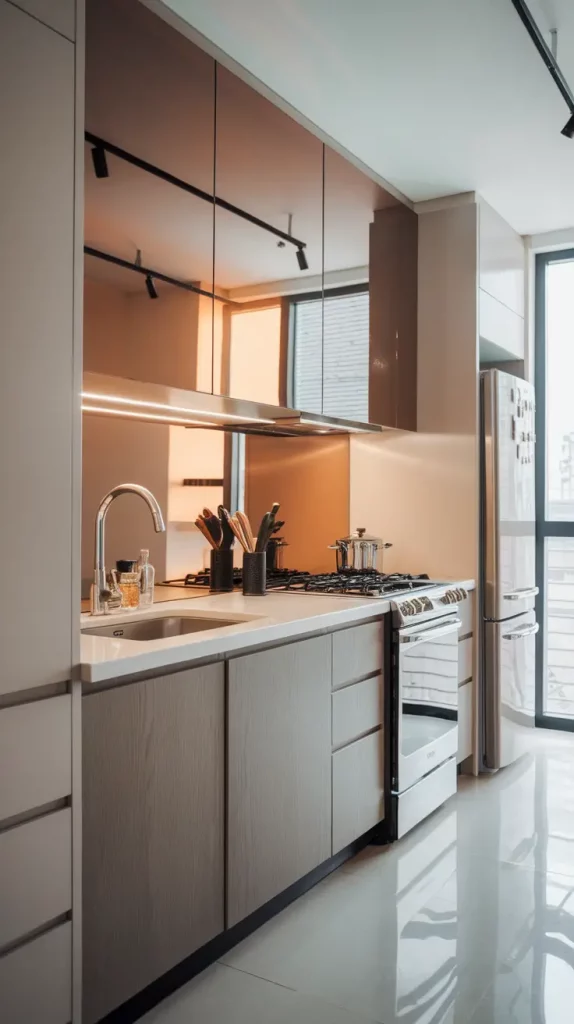
The HGTV’s Small Spaces series featured my implementation of this design for its small loft kitchen renovation project. The transformation was incredible. The transformation took only a few steps to evolve from a confined space into a luxurious environment. The main fingerprint issue can be resolved immediately with a microfiber cloth kept nearby.
The addition of mirrored backsplash would enhance this design by extending the visual illusion across the wall surface while creating a cohesive visual effect.
Neutral Palettes That Visually Expand Your Kitchen Zone
The selection of color significantly determines the perception of space openness in kitchens. Small spaces benefit from neutral color schemes because they generate peace while creating unified appearance and brightness. In designing open kitchen concepts for compact areas I choose to work with cream colors and soft grays together with warm white and earthy tone selections. The selected wall colors create a visual effect that pulls the walls backward while dissolving the separation lines between cooking and living areas.

The color scheme I choose remains consistent between cabinetry and walls and shelving but I introduce variations through material finishes such as combining matte cabinets with a glossy backsplash. The combination of natural wood tones with stone countertops in off-white or beige creates an excellent fusion between the elements. The correct execution of an open layout makes the kitchen fade into the background.

A Scandinavian kitchen design showcased by House & Garden became one of my top favorite neutral designs. The narrow apartment kitchen renovation inspired me to redesign the space with bone-colored cabinets, ivory walls and light wood accents which made the room appear three times larger.
The design effect could be strengthened by applying the kitchen cabinetry tone as a continuous element across to the living area shelf styling. The design thread unites different spaces and improves the perception of space dimensions.
Use Open Islands As Both Dining And Prep Zones
An open island stands as my top choice for compact kitchens because it serves multiple functions in one compact design. Open islands serve as the main element in numerous small-space open kitchen designs because they unite seating areas with storage and preparation surfaces in one attractive unit. For me the perfect island design keeps its bulk minimal through either a rolling rectangular shape or open lower storage.

I incorporate built-in storage features inside the kitchen area and a bar-stool space on the other side through the design. The island materials I prefer include butcher block combined with quartz tops that rest on wood bases. The functionality of your island can be expanded through the addition of towel racks and hooks as well as a drop-leaf section. This piece functions well as a daily breakfast spot and makes an excellent addition to entertaining events.
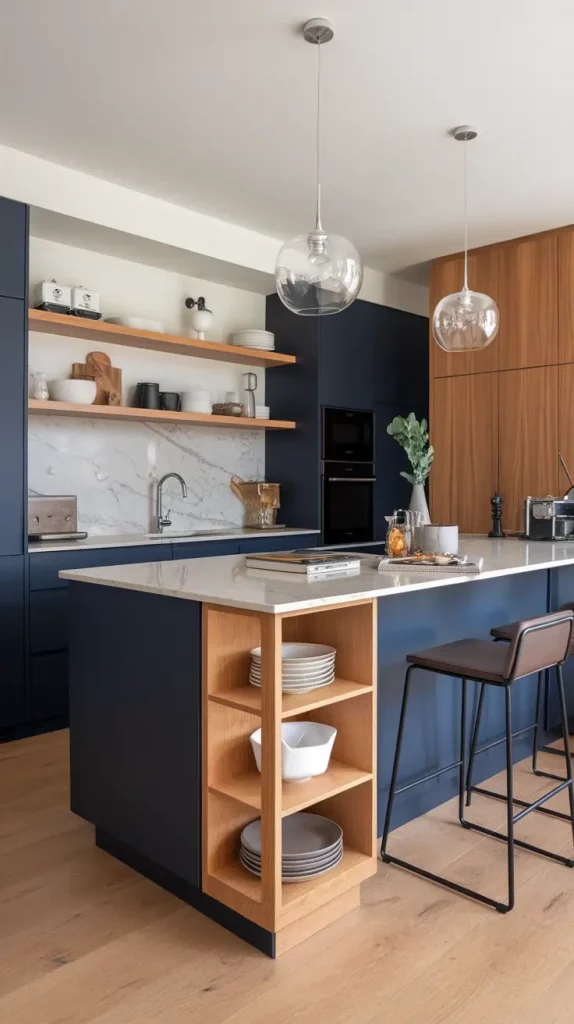
My personal favorite? The Real Simple publication featured this micro loft island design which combined navy paint on the base with oak wood on top. The island remains a constant source of inspiration to me because it perfectly organized the space without blocking it.
I would select an island featuring hidden casters that enables easy movement and repositioning because this feature works best in modular living spaces of the future.
Design An L-Shaped Kitchen That Flows Into Open Areas
The L-shaped kitchen design provides maximum efficiency in small homes because it naturally connects to open areas such as living rooms and dining nooks. The kitchen design features two separate cabinetry sections where one section contains the sink and appliances and the other section transitions into seating or open shelving.
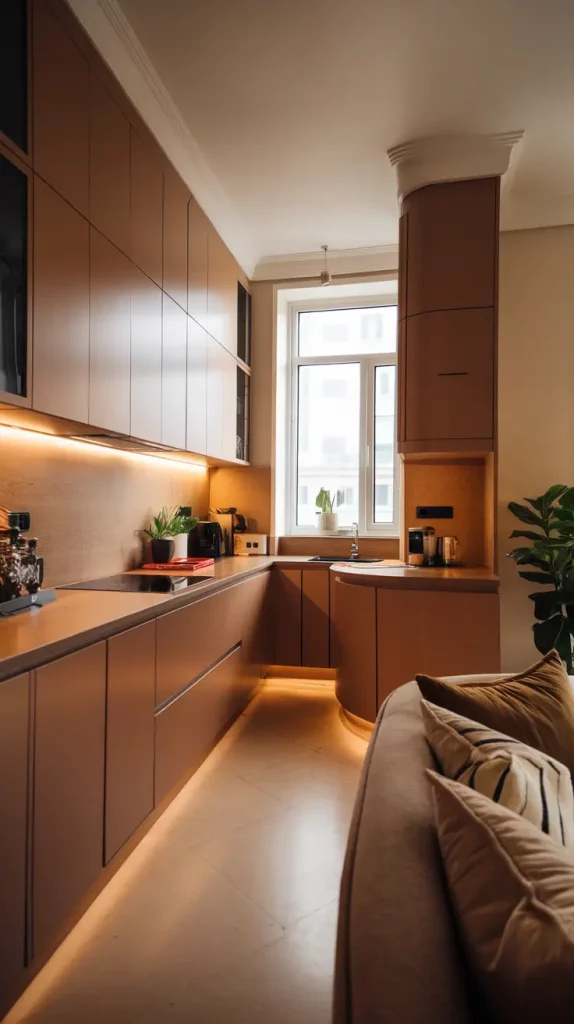
I construct the short cabinet section of the L-shaped kitchen with tall pantry units but maintain an open and spacious design on the long side. The combination of a corner shelf with a wraparound counter serves as functional preparation space and aesthetic connection between areas. The corner area of my designs gets a strategically placed window to bring in maximum sunlight. Soft lighting together with under-cabinet electrical strips add depth to the space.
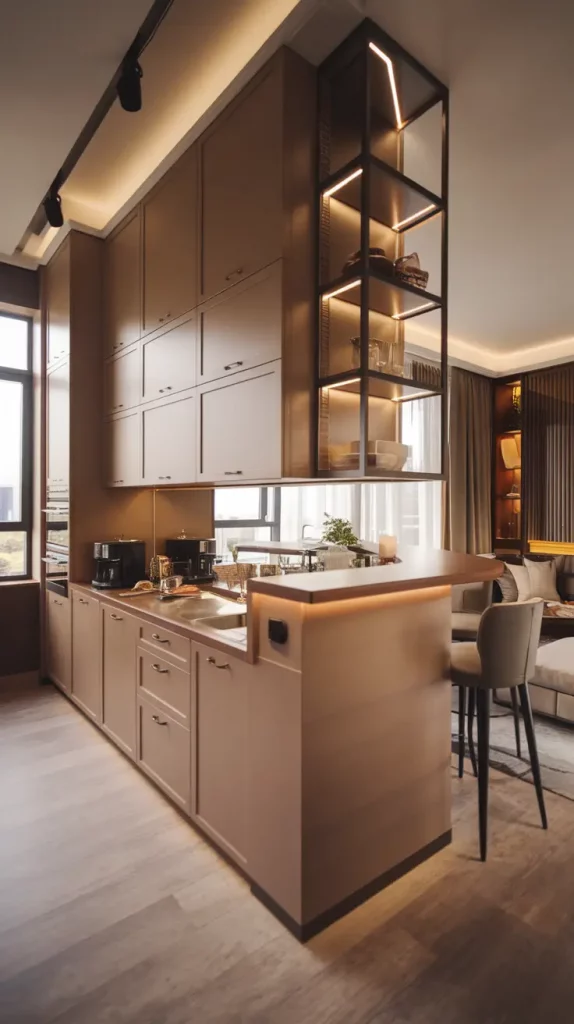
This design approach became the highlight of my work when I applied it to create a seamless transition between a small kitchen and sunken lounge space. We positioned the L-shaped design to fit snugly in the corner before selecting counter height that matched our sectional sofa dimensions. A similar concept recently received praise from Domino magazine because it seamlessly works in small homes.
The L-shape design would benefit from a breakfast bar installed along its outer edge which would enhance functionality while maintaining an open concept.
Built-In Banquettes For Dining In Small Kitchen Nooks
Built-in banquette seating stands as my top pick for open kitchen designs in compact areas when installed within unused kitchen nooks. Built-in seating elements function best in constrained areas that require comfortable eating spaces although a standard dining arrangement is impossible. Built-in bench seating acts as a natural visual highlight and effectively utilizes space that normal designs miss in corners.
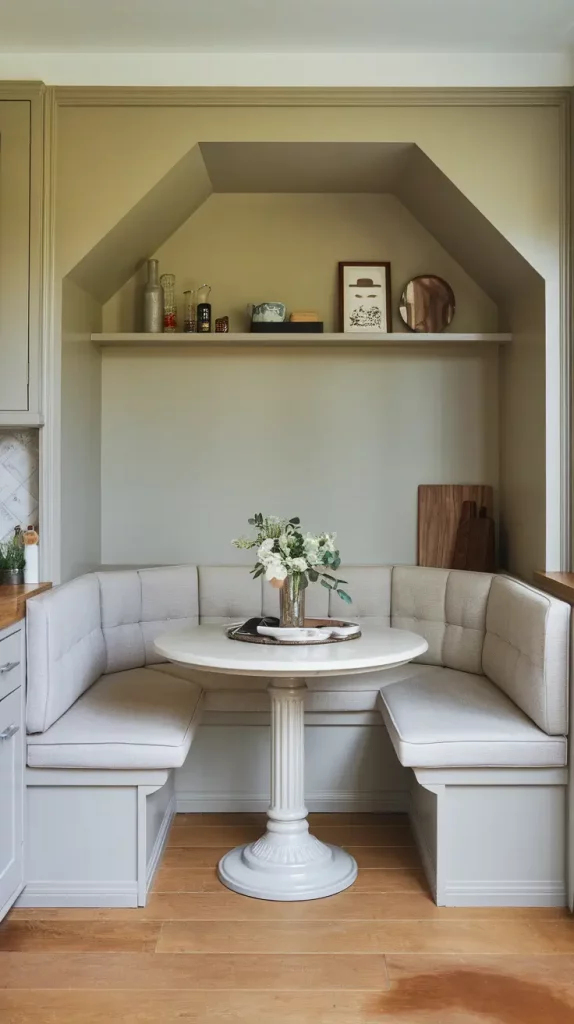
I construct L-shaped or U-shaped benches which rest against walls and have storage areas underneath the seating. The seating area includes a round pedestal table that matches with stackable chairs positioned on the opposite side. The space becomes comfortable and inviting due to stain-resistant upholstery on the cushions. The arrangement works perfectly when used together with a living room area through coordinated color schemes and material choices.

The design has appeared multiple times in my concept tiny house layouts and compact apartment designs. The home publication Better Homes & Gardens identifies built-in seating as an excellent choice for compact living spaces and I completely endorse this recommendation.
A shelf-cum-narrow-cabinet installed above the banquette would serve as perfect storage for tableware and decor items without compromising functional requirements in the dining area.
2025 Trends In Open Kitchen Color Schemes For Small Spaces
The color trends for open kitchen designs in small spaces during 2025 feature powerful yet natural color schemes. The 2025 objective focuses on developing warmth and personality in the design scheme without overpowering the existing layout. The color trends for 2025 include terracotta alongside greige and sage green and off-white shades. The color scheme works perfectly for small kitchens which blend into living areas because it creates a peaceful unified atmosphere throughout the space.

I have incorporated these tones into my latest projects for cabinets and wall paints as well as backsplashes. By joining brass hardware and light wood open shelving and neutral front counters together the result remains both classic and fashionable. Two-tone combinations consisting of clay simplistic lowers with ivory higher cabinets are gaining more acceptance because they introduce visual depth but preserve continuous space.

Architectural Digest has recently highlighted how warm colors generate space warmth which enhances small kitchen spaces for residential environments. The combination of soft underlighting and natural textures such as linen or oak produces an effect that I fully endorse.
A finishing touch would be achieved by introducing textiles that match the chosen palette through items like kitchen towels and seat cushions and window shades which unite all elements.
Create Visual Zones Without Closing The Space Off
Building visual zones is crucial for compact homes running together from kitchens through floor plan living rooms because both areas remain open. I put in continuous effort to keep areas open while making them feel purposeful. The effect of subtle boundaries results from design tool visual zoning which applies materials and lighting together with color schemes.
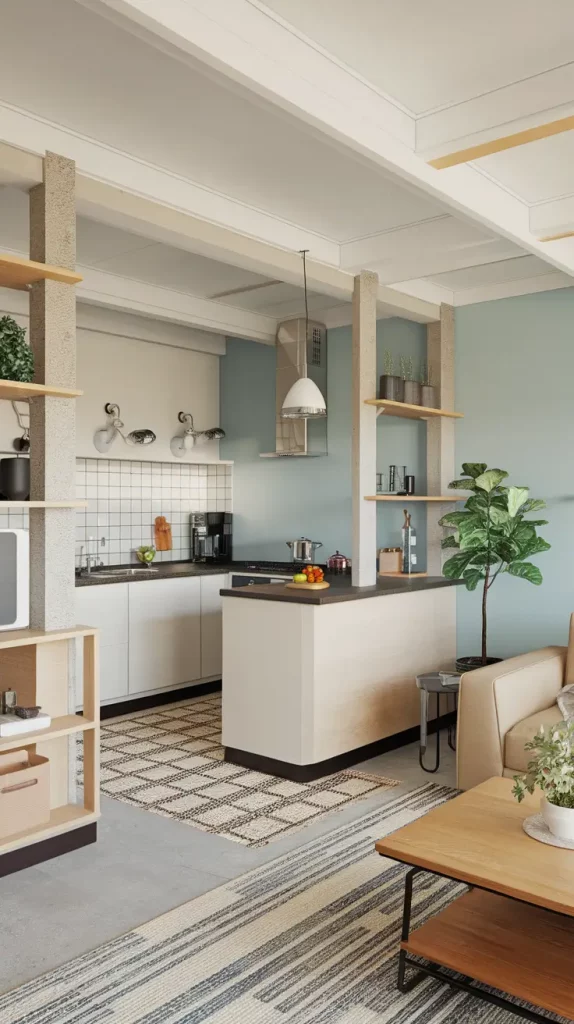
I prefer to use different lighting fixtures between areas such as pendant lights above the island and floor lamps or sconces in the living room section. The transition from herringbone kitchen flooring to straight planked lounge flooring serves as one of my methods to divide spaces. Rugs are another excellent tool. The combination of a kitchen jute runner and a seating area wool rug creates powerful design effects.
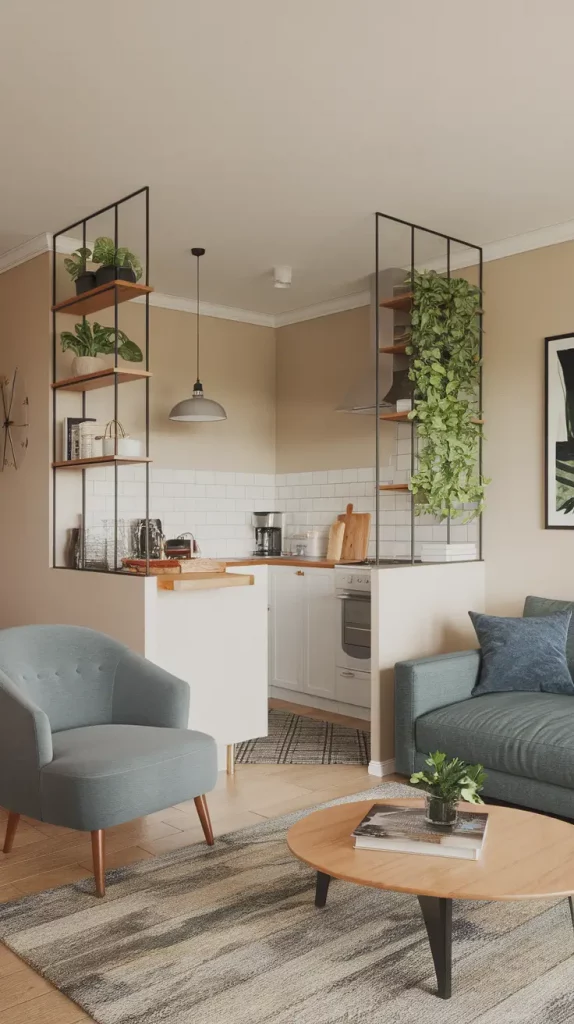
During a one-bedroom apartment renovation I implemented an open shelf as a partition to separate the kitchen from the living area. Light passed through the separation to fill the rooms but each section remained obvious. Domino Magazine frequently demonstrates these zoning techniques through their small home features.
The idea would benefit from implementing either a single kitchen wall painted as an accent or textured wallpaper in the dining area to create visual separation between spaces.
Minimalist Cabinet Designs That Disappear Into The Walls
A kitchen space becomes more spacious when you adopt a clean modern aesthetic design. I use flush cabinets without handles which integrate into the wall surface to achieve an open and non-kitchen-like appearance. The design approach creates a kitchen that disappears into background space which works best when the kitchen shares floor space with other areas.
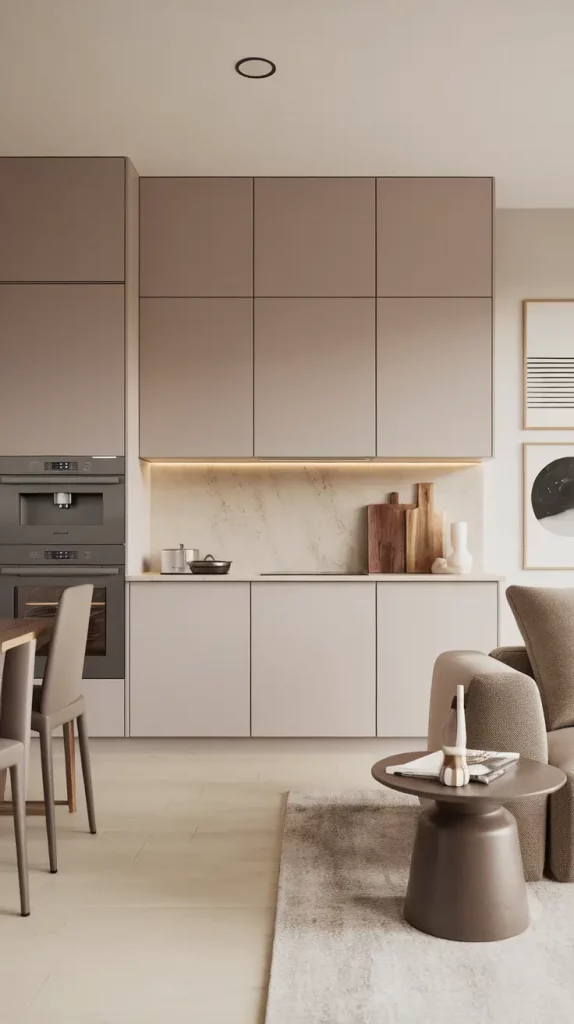
My preferred kitchen design features light-toned matte finishes in taupe and sand and white together with push-to-open concealed mechanisms. The combination of floor-to-ceiling cabinetry functions well because it creates continuous storage while removing visual interruptions. Appliances that integrate into these cabinets create an additional sleek appearance.
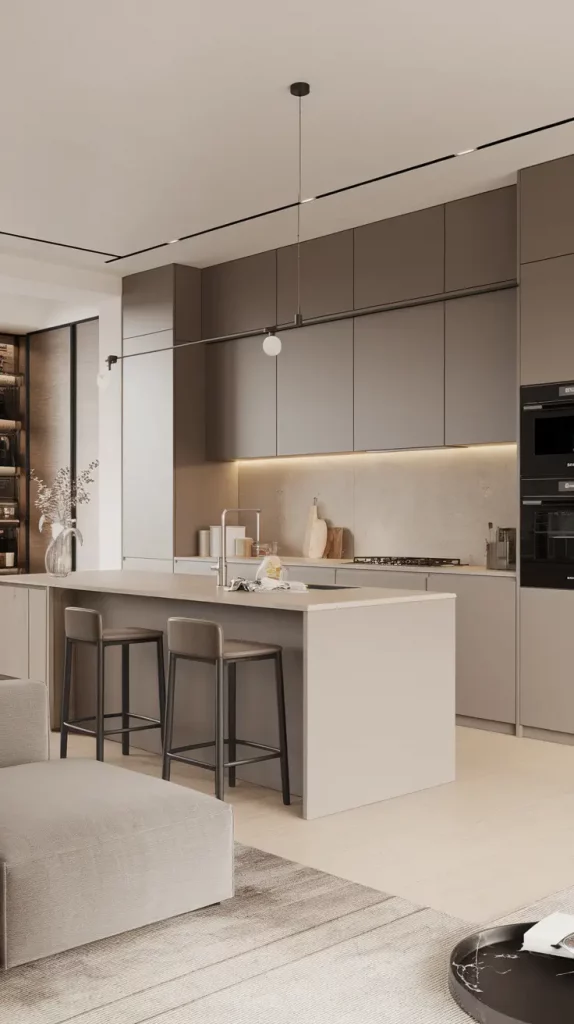
The approach transformed my entire city studio. A Dwell article about urban minimalism motivated me to select flat slab cabinets finished in pale clay. The kitchen area now disappears into the walls so people can view the entire room without interruptions.
You can enhance this approach by creating hidden coffee service areas or slide-out pantries concealed inside the cabinet facade for operational storage without adding visible disturbances.
Utilize Vertical Storage In Narrow Kitchen Corners
The corners of tight and irregularly shaped kitchens remain empty spaces which can serve as optimal locations for vertical storage. Small kitchen dead zones should be transformed into functional pull-out pantry units or high-function shelving towers which serve as my top open kitchen ideas for compact spaces. The key principle involves adding height instead of extending outward.
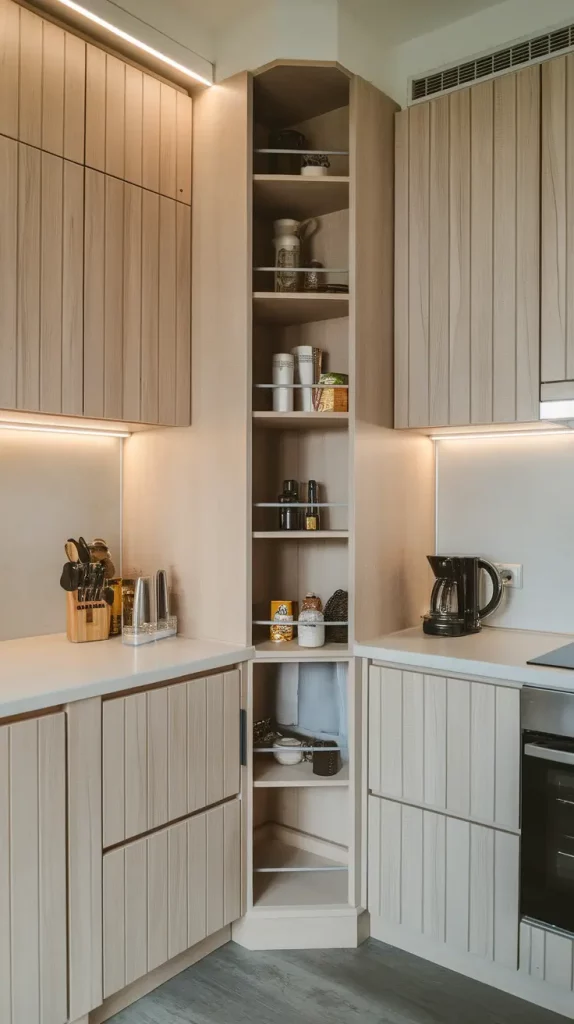
The cabinet design I use for this setup extends from floor to ceiling with adjustable shelves inside. I chose to install wall-mounted ladder shelves which provide open storage for pantry items and dishware and plants. The vertical design elements produce an optical effect that extends space vertically while enhancing sophistication.
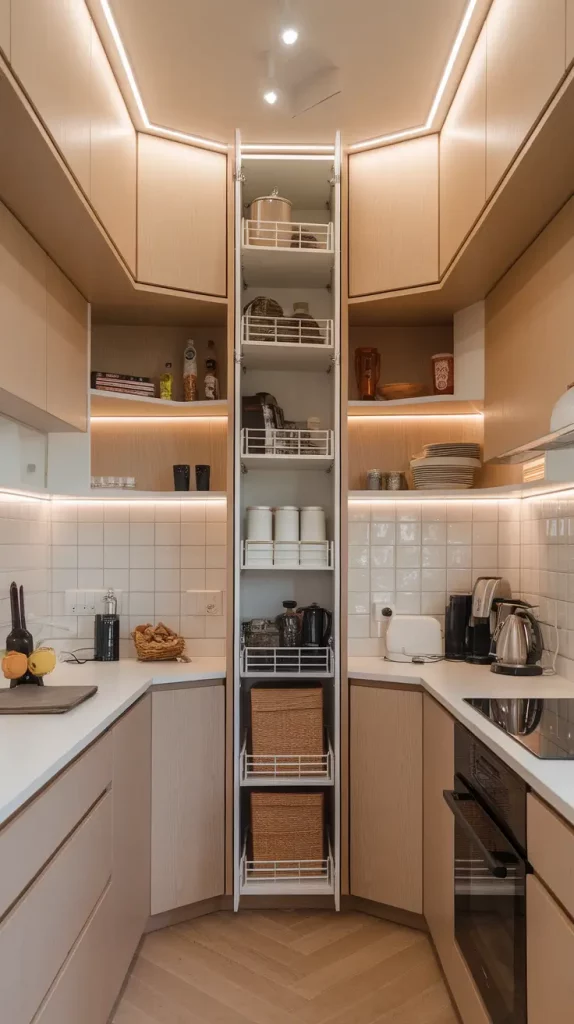
The concept tiny house client received assistance from me to create a pull-out spice rack and tall broom closet combination that fit perfectly in a tight space next to the fridge. The space arrangement underwent a total transformation because of this change. Apartment Therapy regularly showcases effective vertical space-saving solutions which actually produce outstanding results.
Vertical units commonly lack proper illumination as one of their main design flaws. LED strips with motion sensors should be placed inside the cabinets and behind each shelf to serve both practical and decorative purposes.
Glass-Front Cabinets That Add Openness Without Clutter
Glass-front cabinets provide a solution for those who want kitchen openness but not complete open shelving. The transparent glass features of cabinet doors let light shine through to establish visual depth while discretely storing ordinary items beyond view thus creating the best solution for visually appealing limited kitchen spaces.

The choice between frosted or ribbed glass delivers a contemporary blurred appearance yet clear glass showcases the dishes as art pieces. I arrange and match the interior colors of all cabinets in both situations. The interior lighting system uses LEDs to improve the appearance of these cabinets while providing a warm and inviting illumination.
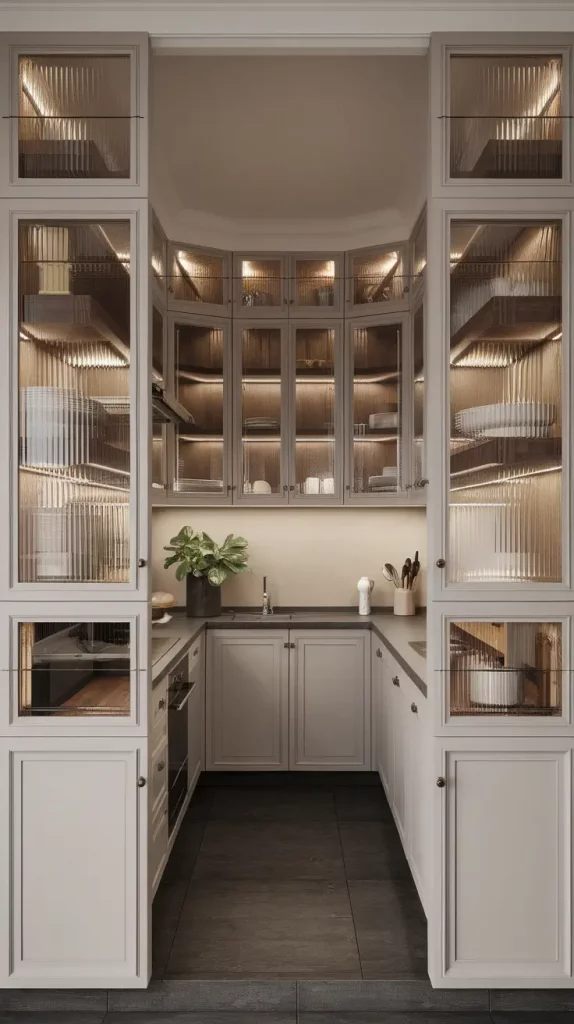
This transformation proved to be the key element during a recent budget remodeling project. We chose to install glass inserts instead of removing the uppers which brought an instant upgrade at a minimal cost. Real Simple featured this kitchen design trick to create an illusion of enlarged spaces which I have witnessed many times.
Patterned glass and reeded textures should be used more frequently because they provide both elegance and practical mess diffusing properties.
Small Kitchen Layouts With Big Style Impact
An exceptional design impact can emerge when you organize existing elements with creativity. The design layout stands equal to the finishes when creating a small kitchen space. The arrangement of appliances and shelving and counters in galley-style and single-wall and U-shaped formats determines both functionality and visual appeal of the space.
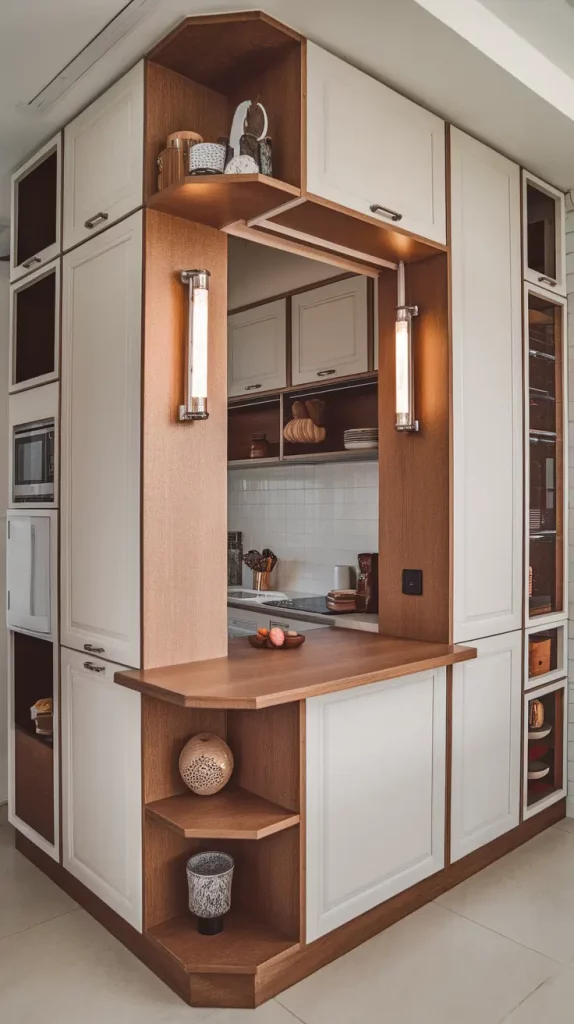
The single-wall kitchen represents my top choice when designing highly compact living spaces because it pairs well with floating islands or peninsulas. The living room area benefits from this layout which maintains all kitchen activities neatly organized in a single row. Open shelves above counters enhance an open atmosphere while tall cabinets at distance ends provide structural support in the design.

This design principle exists throughout city lofts and tiny house concepts that I have observed. The television network HGTV showcased a 500 square foot house with its entire kitchen designed as a single wall arrangement which maintained its elegant and functional appearance.
Three key lighting fixtures made of compact units can enhance this design idea – a main fixture with under-cabinet lighting and an accent pendant placed above the prep area.
Mix Materials Like Wood And Metal For Visual Interest
Open kitchen designs that use material blending stand as the best hidden technique for small spaces. A small space benefits from arranged textures between wood and metal elements which generate depth through design features without becoming visually overwhelming. This design approach helps me add visual appeal to modern and neutral kitchens when they connect to living areas.

The combination of matte black metal accents with wood cabinetry and reclaimed wood storage combined with industrial illumination produces an effect that I really enjoy. Stools with metal legs and brushed steel backsplashes harmonize perfectly with the gentle appearance of wooden surfaces. Using aged brass elements either singularly as a pendant or faucet will reshape a minimalist design into a more considered aesthetic.
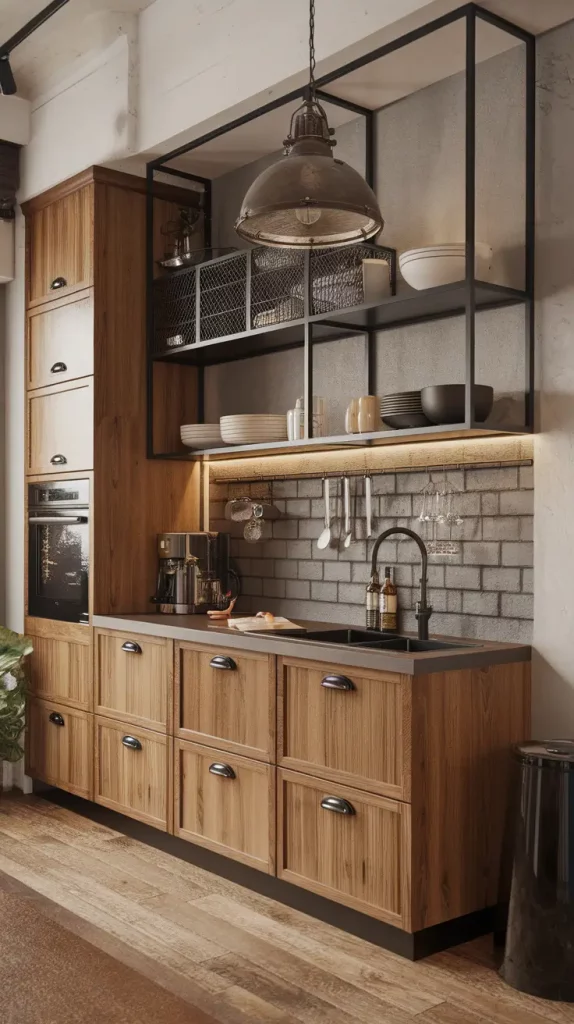
The combination of white oak cabinets which met brushed nickel fixtures produced a soothing yet impressive outcome in my recent kitchen design. The combination of materials used in this style appears frequently in Elle Decor features while remaining a key design element for 2025 predictions.
A wood-and-metal rolling island would serve as an effective way to enhance the overall appearance. The element enhances adaptability and continues to build the mixed material framework.
Use Statement Shelves As Both Decor And Storage
Working with limited space requires each decorative element to serve dual purposes and statement shelves excel at this task. These shelves fulfill dual roles by holding contents while also drawing attention to the space and that perfectly suits compact arrangements. I construct wall-to-wall rectangular shelving units with organized spaces between storage for both efficient household needs and design purposes.

My preference for furniture includes shelves that float from the wall using materials such as live edge wood and blackened steel and painted MDF. You should arrange decorative items with books alongside kitchen accessories such as mugs and jars and bowls on floating shelves. The visual arrangement gain organization and purpose from my use of balanced designs and repetitive layout patterns.
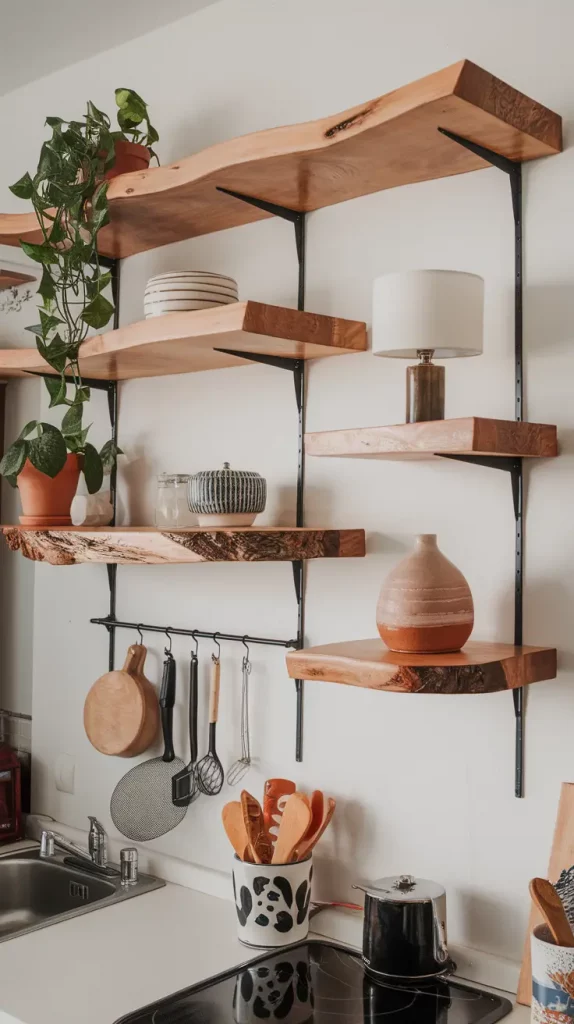
I built a five-tier shelving system which extended from the kitchen to the living room to form a single design element. The client drew inspiration from a Dwell magazine photo shoot to achieve a sculptural design that maintained ample storage space which we successfully executed.
I would improve the design by adding lighting systems that embed within the shelf structure or rest beneath its surface. The installation of lighting under or within shelves improves both appearance and nighttime accessibility.
Incorporate Lighting To Define Kitchen Zones Creatively
The implementation of smart lighting technology leads to complete transformation of compact kitchen areas. The integration of proper illumination serves as a primary mechanism to establish delicate divisions within open kitchens that exist within limited spaces. The lighting design serves two functions: it provides functional illumination while also creating ambiance to define different areas especially in spaces that share a floor plan with the living room.

The lighting strategy consists of three elements with recessed ceiling fixtures for room illumination together with under-cabinet task lighting and pendulant fixtures above eating areas and islands. The mood shifts throughout the day because I use dimmers and color-adjustable bulbs as lighting control. The brass pendant cluster hanging from above the island created an independent visual appeal while maintaining space connectivity.

The 2025 House Beautiful overview mentioned that outstanding lighting features will maintain their relevance for compact domestic designs which I regularly observe in practice. The implementation of layered lighting creates a positive response from clients above all other possible kitchen improvements.
The final design feature I would incorporate would be either toe-kick lighting or low-profile LEDs for floating cabinets. The soft illumination during nighttime enhances the appearance of the entire design.
Sliding Panels That Reveal Or Conceal Your Kitchen
A small home with an integrated kitchen benefits tremendously from sliding panels that let you temporarily hide the space. Sliding panels represent a modern and functional solution which I have incorporated into various tiny house and studio design concepts. These panels enable the kitchen to blend into the room’s design when open yet vanish when you need them to disappear.

My choice of materials for sliding panels consists of frosted glass and wood slats and minimalistic metal frames. These panels exist in two installation options: they can be attached to the ceiling or placed inside an overhead track that runs next to the counter. The sliding panels function as decorative walls while open but provide storage area and appliance concealment when closed.
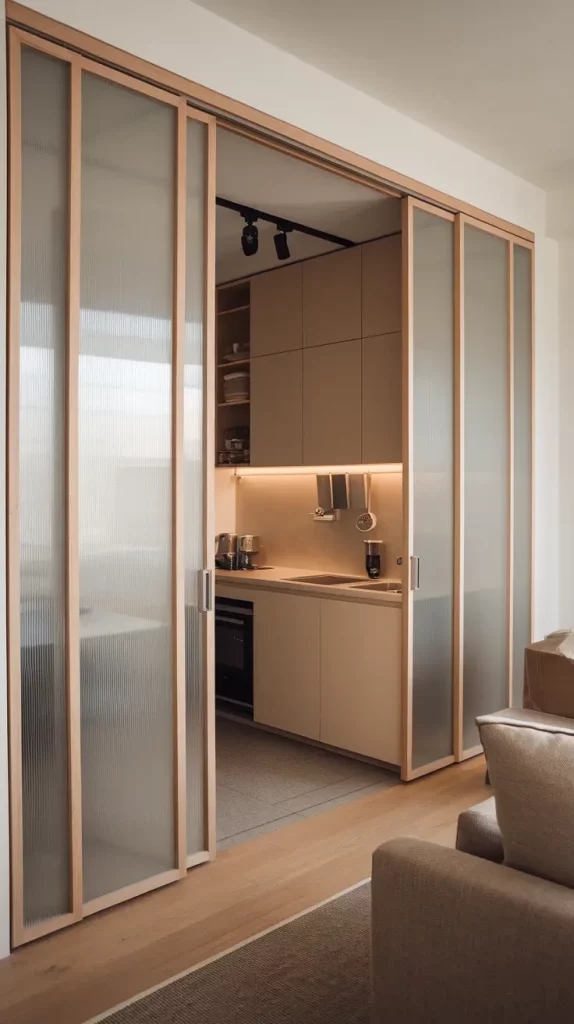
I built a semi-transparent white oak partition to partition my kitchen from the entryway in my apartment. The partition design I created after seeing Japanese concepts on Dezeen allows light entry while maintaining the functional character of the room.
A built-in handle cutout and magnetic catch system should be incorporated to enable smooth sliding of the feature. Using panels that match other room surfaces creates a unified appearance.
Chic Scandinavian Open Kitchens For Compact Spaces
Small space open kitchen designs continue to follow Scandinavian style because it delivers practicality combined with simplicity and fresh air aesthetics. The style incorporates pale tones and natural materials with easy-to-use designs to create the most out of compact spaces. Shared floor plan living rooms benefit from this design approach because it depends on visual harmony.
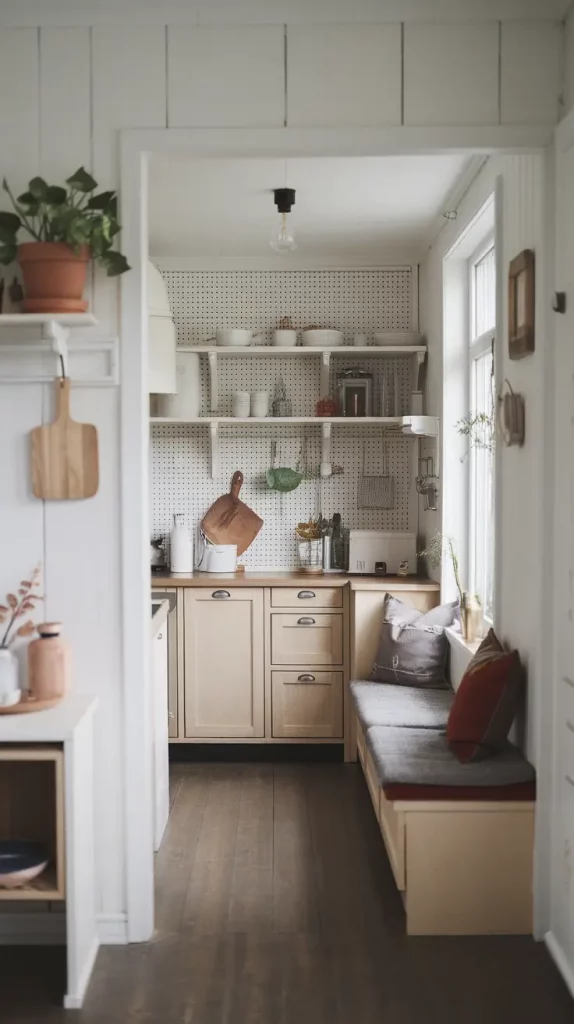
I select white or light wood cabinets with open shelves alongside linen pendant lights and ceramic handles as my design elements. The kitchen surfaces are made from wood or matte stone materials while appliances stay concealed from view. The intended purpose of each item exists without creating a sterile atmosphere.

During the previous year I designed a small kitchen utilizing METOD from IKEA and built personalized birch shelves then installed brass faucets. The dimensions made it appear bigger than its actual size while carrying a 2025 zeitgeist. The aesthetic works exceptionally well for small apartments and Nordic-inspired buildings according to both Domino and Scandinavia Standard.
The next step in developing this design would be adding pegboard backsplashes for modular storage and a breakfast bench positioned in a corner.
Open Kitchen Ideas That Work In Studio Apartments
Designing a studio apartment requires the greatest design challenge because all living spaces must fit into a single room. Open kitchen designs for small studio apartments require space-saving approaches which also include styles that please the eye. When working on these spaces I implement modular thinking by establishing separate functional areas instead of construction walls.
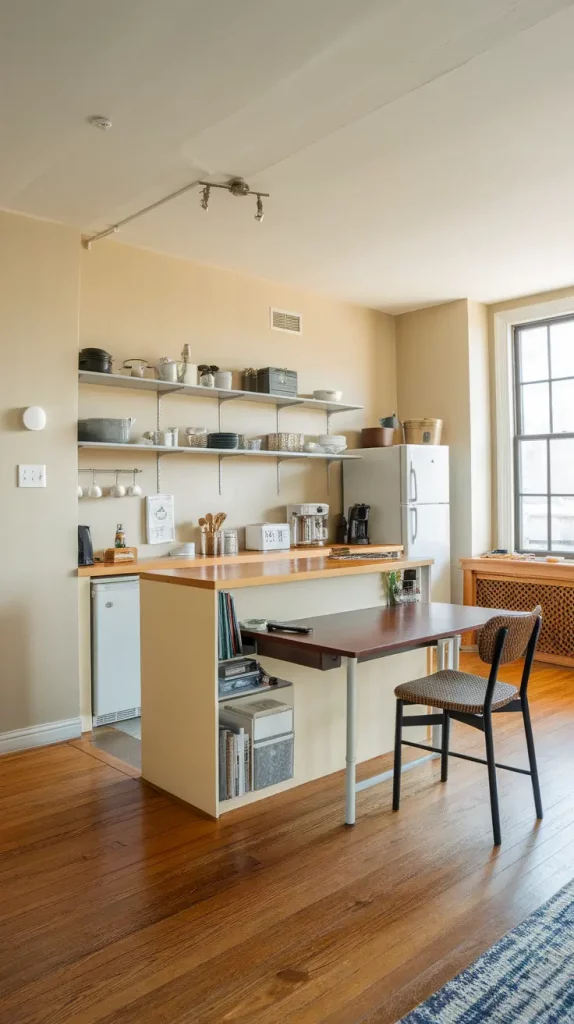
The single-wall kitchen design stands as my preferred choice for studios because it works best with narrow islands or peninsulas. My design choices include thin cabinets and built-in appliances together with open shelving which serves as partition walls. A studio design can unify living space through continuous selection of materials which prevents separation between kitchen and living area.

We designed a 400 sq ft downtown studio which featured a hidden appliance installation together with an island that transitioned into a work-desk solution. A design layout similar to this one appeared in Architectural Digest as an example of upcoming small-space living solutions.
The addition of pocket doors that disappear into walls would be my top modification to the design.
Stylish Compact Appliances That Save Space
The appliances in a small kitchen determine its success or failure. The design of open kitchen ideas for small spaces requires me to select slim integrated stackable units. Modern appliance manufacturers offer a wide range of products which allow you to achieve a complete kitchen setup without using excessive space.

My search includes 18-inch dishwashers together with narrow fridges and two-burner cooktops. The combination of wall-mounted ovens with washer-dryer units works well for small house designs including micro-lofts. Panel-ready appliances provide the best option because they disappear within the cabinetry framework to prevent visual distraction.
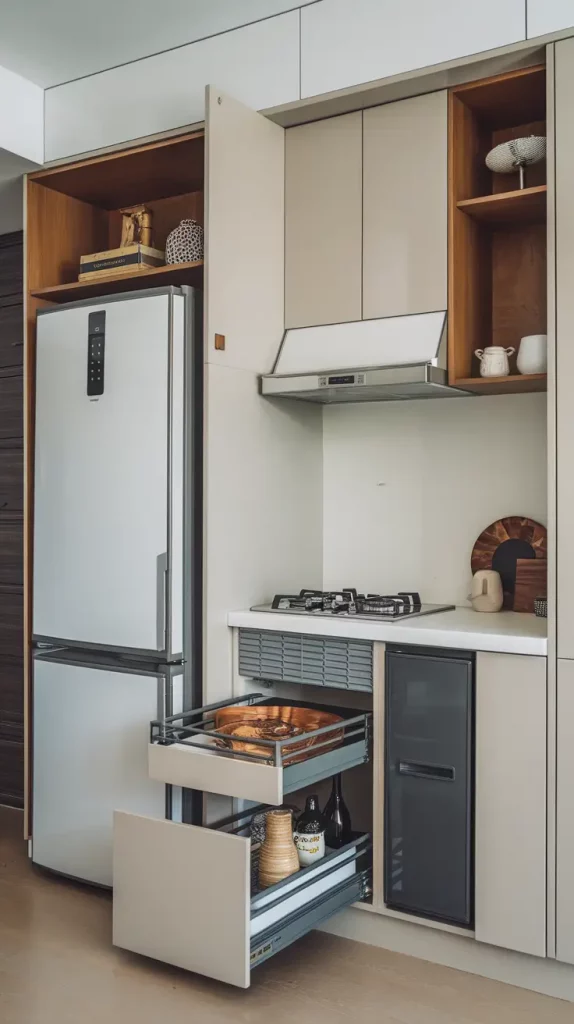
I incorporated a 24-inch SMEG fridge and a pull-out pantry next to a two-drawer dishwasher during the coastal cottage remodel project. The design outcome produced an elegant and usable product. Real Simple included these units in their “best compact appliances” list for 2025 while I can personally verify their outstanding performance.
The final elements in this design would include either a hidden coffee station built into a shelf niche or a compact microwave drawer which provides both style and efficient space utilization.
Make Use Of Empty Walls With Magnetic Or Pegboard Systems
I always consider empty wall space as a wasted potential while working in compact kitchens. A blank wall becomes a practical addition to your space through the implementation of magnetic or pegboard systems which serve as one of my preferred open kitchen ideas for small spaces. These storage systems work well in areas connecting living rooms because they provide attractive storage without taking up much space.

The installation of a full-height pegboard wall receives my preference for kitchen storage solutions. This wall receives paint to match the space and I add modular hooks and bins and rails for functionality. Magnetic strips function to hold knives and spice jars and they can also support a foldable dish rack. The systems function well with both renters and budget-conscious users since installation and customization remain simple.

The concept tiny house kitchen gained a magnetic wall implementation from me. The new tool system occupied the space of three drawers while maintaining everything within easy reach without creating any visual clutter. Apartment Therapy demonstrates real-life effective DIY solutions that match their showcased examples.
A built-in message board or magnetic chalk strip would be my additional choice since it enables meal planning and grocery list writing without requiring countertop space.
Smart Flooring Choices That Extend The Kitchen Aesthetic
Flooring is a crucial element in small-space open kitchen designs because it connects the kitchen to the floor plan living room. The design objective combines continuous visual continuity with a specific yet understated character for the kitchen space. My design approach involves extending the flooring between zones by using different finish types and color tones and textural variations.
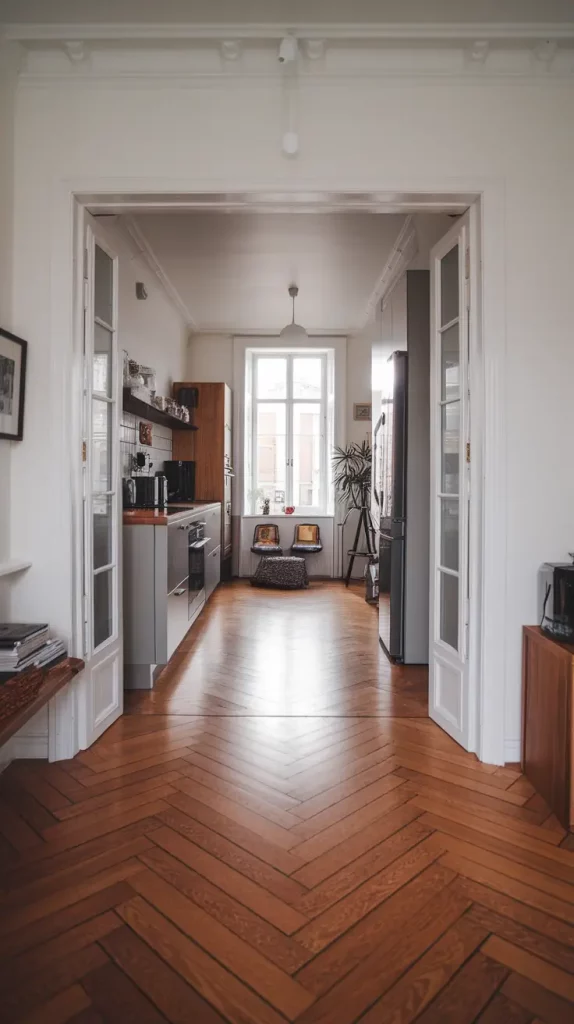
For modern kitchen designs I most frequently select engineered hardwood or luxury vinyl tile products because they create a smooth flow between kitchen areas and various other living spaces. The kitchen features chevron tiles but the other areas display straight planks. These waterproof materials deliver affordability in addition to their suitability for intensive traffic areas. Area rugs and runners provide effective space division while keeping the existing materials intact.
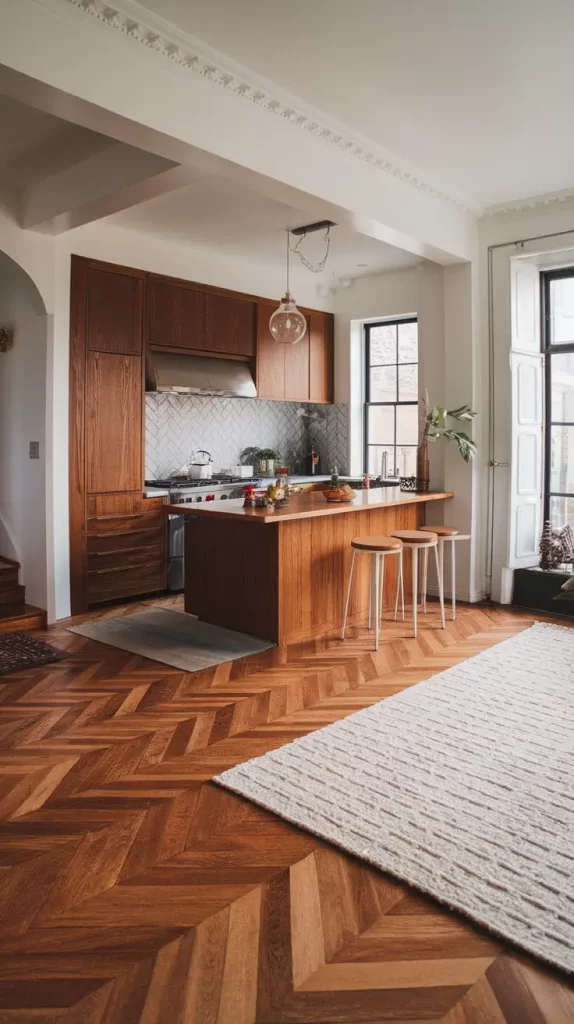
The modern loft application stands out to me because we installed pale oak planks across all areas and placed a textured stone-look vinyl inlay under the island. HGTV supports the layering technique described above as a way to create visual cohesion and subtle guidance in interior spaces for the year 2025.
The installation of radiant heated flooring in small kitchens remains one of my top desired trends because it provides space efficiency through radiator removal and delivers luxury without occupying visual room.
Conclusion
Small kitchens become stunning features of a well-designed functional space. Any room including the tiniest spaces can be turned into an efficient yet pleasing arrangement by focusing on layout design together with materials selection and color choice and suitable shelving options. Every budget level and every type of project and every studio floor plan living room renovation has at least one solution to maximize efficiency. Share your best design plans for 2025 through comments with the open kitchen ideas from this article.


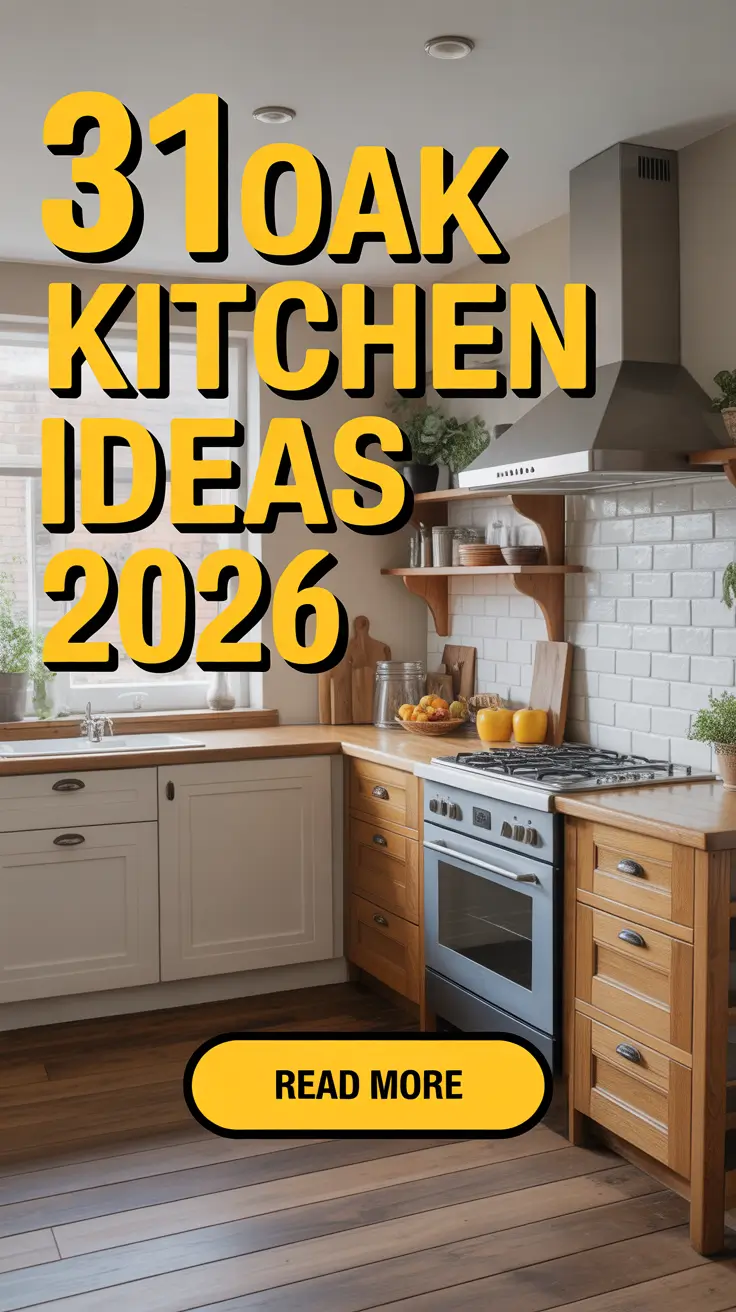
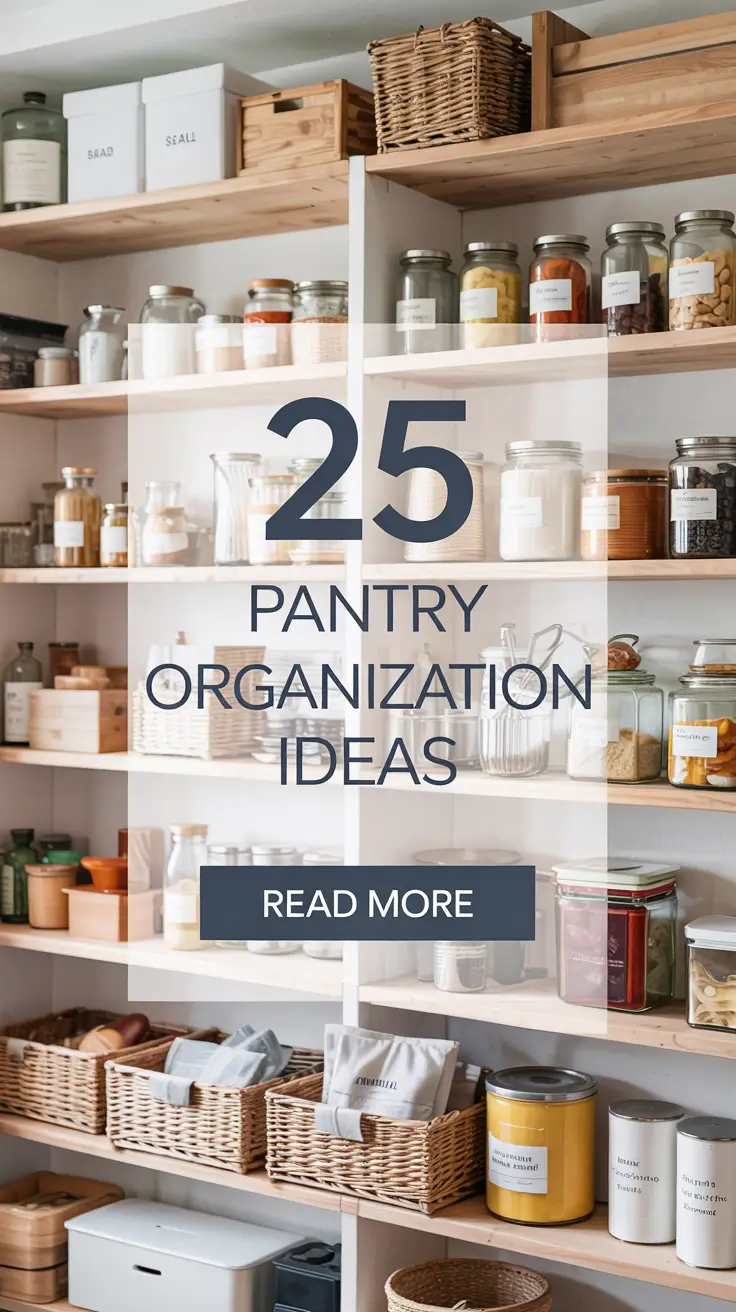
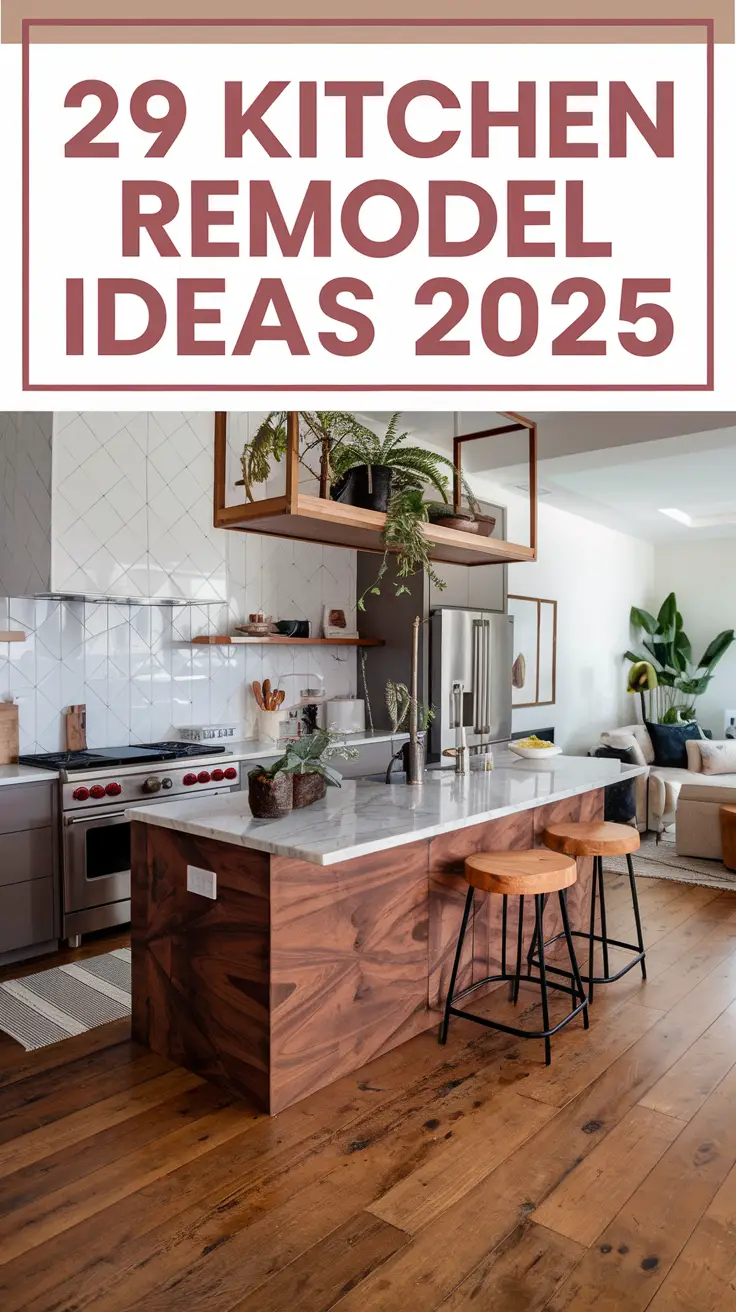
Perfect piece of work you have done, this website is really cool with superb information.
thank you ❤️